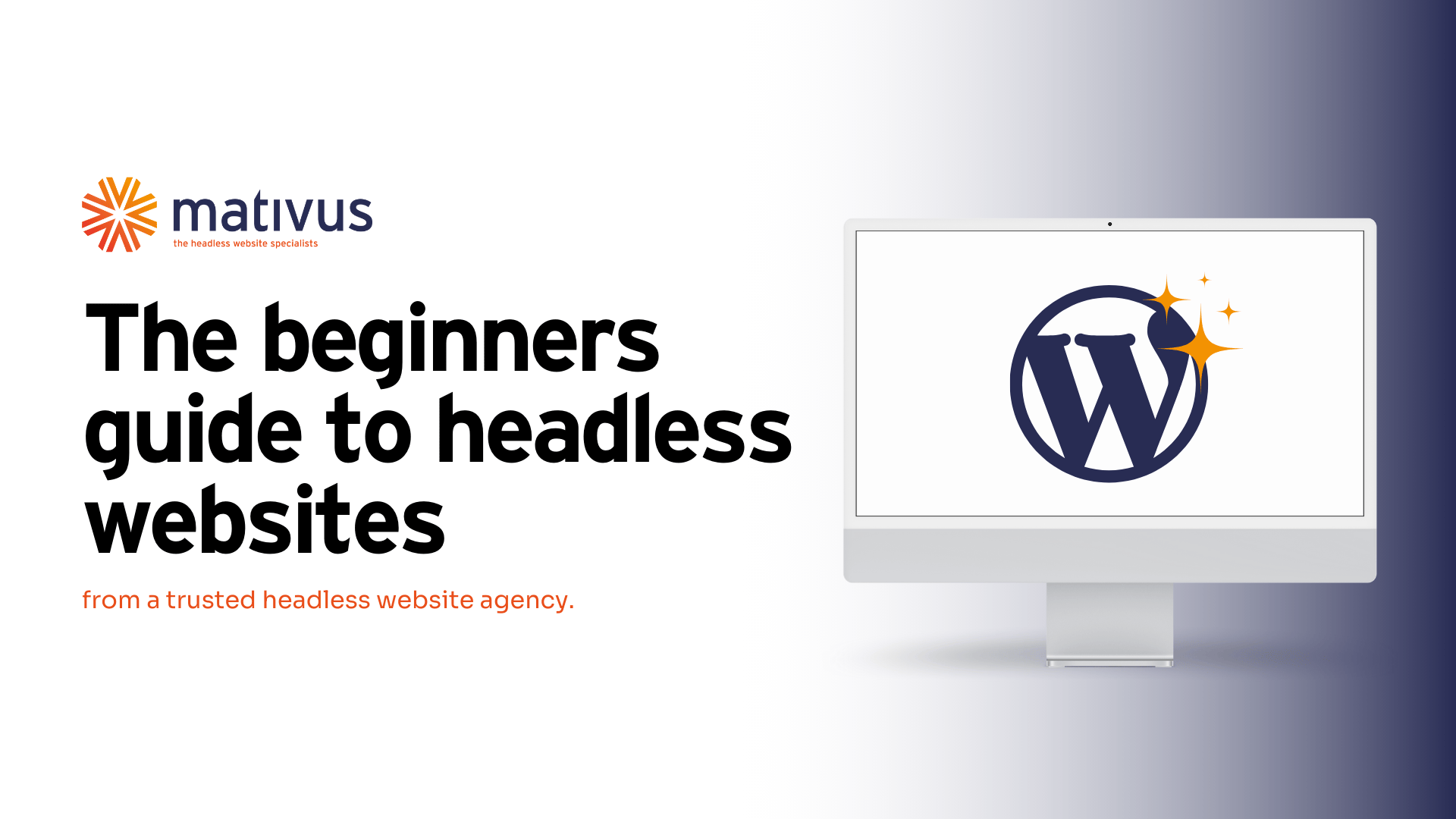Guides

The beginners guide to headless websites
By Robbie Mould
02 Mar 2025 • 8 min read
Share this post

Have you ever felt like your website isn’t bringing in the discovery calls you need with your best clients?
Do you find yourself limited by the traditional setup, wishing for more flexibility and control?
Or maybe you’ve heard the term “headless WordPress” and aren’t quite sure what it means.
If you’re familiar with WordPress but new to the concept of headless architecture, you’re in the right place. This guide will break down everything you need to know about headless WordPress websites in a straightforward, easy-to-understand way, no technical knowledge required!
TL;DR
Headless websites separate the Content Management System (WordPress) from the website’s front-end (what visitors see in the browser).
This setup offers greater flexibility, faster performance, and the ability to deliver content across multiple platforms like websites, mobile apps, and more.
While it may require a bit more setup initially, headless WordPress is ideal for those looking to scale their online presence and embrace modern web technologies.
(Watch a 4 minute video explaining everything you need to know…)
What is a Headless Website, and why should I care?
If you’ve ever felt frustrated by how clunky or limiting your website is, this is for you.
A headless website separates the content management (like WordPress) from the visual design of your site. Instead of one system doing everything, it splits the job in two – and that’s a good thing.
Here’s why small business owners love when their website works smarter:
-
Faster load times – which keeps visitors on your site and improves Google search rankings.
-
Easier to scale – change your website’s design or functionality without starting from scratch.
-
More secure – fewer moving parts exposed to hackers.
In short: it’s the modern way to build a high-performing website that grows with your business.
Still using a traditional setup? You’re likely paying the price in speed, flexibility, and missed opportunities.
Why are so many businesses switching?
There are several reasons why someone might choose a headless website setup over the traditional one:
- Flexibility: Choose any front-end technology you like (e.g., GatsbyJs React, Vue.js) to design your website’s appearance and interactions.
- Performance: Deliver content faster with optimised front-end frameworks and better caching strategies.
- Multi-Channel Delivery: Share your content seamlessly across various platforms like mobile apps, digital kiosks, or even smart devices.
- Future-Proofing: Stay ahead with the latest web technologies without being tied down by WordPress’s theme and plugin limitations.
What are pros and cons of switching to a headless website?
To help you decide if headless WordPress is right for you, here’s a table summarising the main advantages and disadvantages of both traditional and headless architectures.
| Aspect | Traditional WordPress | Headless WordPress |
|---|---|---|
| Setup Complexity | Simple and quick to set up | More complex; requires separate front-end development |
| Flexibility | Limited by themes and plugins | High flexibility; use any front-end technology |
| Performance | Can be slower with heavy plugins | Potentially faster with optimised front-end |
| Multi-Channel Support | Primarily web-focused | Excellent; content can be delivered to multiple platforms |
| Maintenance | Easier for non-technical users | Requires technical expertise for both front and back-end |
| Cost | Lower initial cost | Higher initial investment, but better long-term ROI |
| Ideal For | Small businesses, beginners, simple websites | Medium to large organisations, complex and scalable sites |
How do I get started with Headless WordPress?
If you’re convinced that headless websites might be the way forward for your website, here’s a simple step-by-step guide to get you started:
- Understand Your Needs:
- Determine why you want to go headless. Are you looking to improve performance, expand to multiple platforms, or embrace new technologies?
- Choose Your Front-End Technology:
- Decide on the front-end framework you want to use. Popular choices include React, Vue.js, and Angular. These frameworks allow you to create dynamic and responsive user interfaces.
- Set Up WordPress as a Headless CMS:
- Install WordPress on your server as usual. Then, disable the front-end themes and focus solely on using WordPress as a content repository.
- Use plugins like WPGraphQL or the REST API to enable your front-end to fetch content from WordPress.
- Build Your Front-End:
- Develop the front-end using your chosen framework. This involves creating the design and user experience separately from WordPress.
- Connect your front-end to WordPress via APIs to pull in content.
- Test and Optimise:
- Ensure that your content displays correctly on all platforms.
- Optimise performance by implementing caching and other best practices.
- Launch and Iterate:
- Once everything is set up and tested, launch your headless WordPress site.
- Continuously monitor performance and make improvements as needed.
What makes headless websites faster, more secure, and easier to manage?
For medium to large organisations, the benefits of headless WordPress are particularly pronounced:
- Scalability: Easily handle increased traffic and content without the performance issues that can plague traditional WordPress sites.
- Enhanced Security: Reduce vulnerabilities by limiting the reliance on plugins, which are often a source of security risks.
- Greater Control: Tailor every aspect of your website’s front-end without being constrained by WordPress themes and plugins.
- Innovation: Integrate the latest technologies and deliver content across multiple channels effortlessly, keeping your digital presence cutting-edge.
Wondering how much it costs? View our headless website pricing and packages to see what’s included.
Are there any potential drawbacks to think about?
While headless WordPress offers many advantages, it’s important to be aware of the potential drawbacks:
- Increased Complexity: Managing separate front-end and back-end systems requires technical expertise and a more involved setup process.
- Higher Initial Costs: Development costs can be higher due to the need for custom front-end development and integration work.
- Maintenance: Ongoing maintenance may require a team with diverse technical skills, as you’re no longer relying solely on the WordPress ecosystem.
When should I choose Traditional WordPress website?
Many small business owners still start with a simple site. The problem? It often looks nice but doesn’t bring in high-value clients. That’s why we created The Mativus Platform, an all-in-one growth system that turns your site into a discovery-call booking engine.
- Small Businesses and Start-Ups: If you need to get a website up and running quickly without extensive resources, traditional WordPress is ideal.
- Simple Websites: For blogs, portfolios, or basic business websites, the traditional setup is sufficient and cost-effective.
- Limited Technical Resources: If your team lacks the technical skills required for headless setups, sticking with traditional WordPress can save time and money.
Who should opt for Headless WordPress?
Headless WordPress is better suited for:
- Growing Businesses: As your organisation expands, the flexibility and scalability of headless WordPress become more valuable.
- Complex Websites: If you require advanced features, multi-channel content delivery, or highly customised user experiences, headless WordPress offers the tools to achieve this.
- Future-Proofing: To stay ahead with the latest web technologies and ensure your website can adapt to future changes without major overhauls.
But, what are they like in the real-world?
To illustrate how headless WordPress can be used effectively, consider these examples:
- E-Commerce Platforms: A headless setup allows seamless integration with e-commerce tools, offering a faster, more responsive shopping experience.
- Media Sites: News websites and online magazines can deliver content across multiple platforms, such as websites, mobile apps, and smart TVs, without duplicating effort.
- Corporate Websites: Large organisations can manage complex content structures and deliver personalised experiences to different user segments efficiently.
Common myths debunked
There are several misconceptions about headless WordPress. Let’s clear them up:
- Myth 1: Headless WordPress is Only for Developers:
Fact: While technical expertise is needed for setup, the benefits are accessible to non-technical teams who can manage content through the WordPress admin interface. - Myth 2: Headless WordPress is More Expensive:
Fact: Although initial costs can be higher, the long-term benefits of scalability, performance, and flexibility often result in better ROI. - Myth 3: SEO Suffer in Headless WordPress:
Fact: Properly implemented headless sites can achieve excellent SEO performance, often better than traditional setups due to faster load times and more control over metadata.
How can I help ensure a successful Headless WordPress implementation?
- Plan Thoroughly:
Define your goals and understand the benefits headless WordPress can bring to your organisation. - Choose the Right Team:
Ensure you have the necessary technical expertise, whether in-house or through a trusted partner. - Start Small:
Begin with a pilot project or a single section of your website to test the headless approach before a full-scale rollout. - Focus on Content Strategy:
Maintain a strong content strategy to ensure your content is effectively managed and delivered across all platforms. - Invest in Performance Optimisation:
Use caching, CDNs, and other optimisation techniques to maximise the performance benefits of a headless setup.
Is Headless WordPress right for my business?
Headless WordPress offers a powerful way to enhance your website’s flexibility, performance, and scalability.
While it may not be necessary for every organisation, medium to large businesses looking to grow and innovate will find significant advantages in adopting this modern architecture.
By separating the back-end content management from the front-end presentation, headless WordPress empowers your team to deliver exceptional digital experiences across multiple platforms, ensuring your website remains future-proof and adaptable to changing market demands.
If you’re ready to take your WordPress site to the next level, consider exploring the headless approach. It might just be the upgrade your website needs to support your business’s ongoing growth and success.
Not sure if headless is right for you? Check out our comparison of headless vs traditional websites to weigh up your options.
What are the next steps?
Ready to dive into headless WordPress? Start by consulting with a developer or a digital agency experienced in headless architectures.
Assess your current website’s needs and future goals, and plan a phased approach to transition smoothly.
Embrace the flexibility and power of headless WordPress to create a website that not only meets today’s demands but is also prepared for tomorrow’s innovations.
Or hear from our customers to learn about their experience
“Excellent fast and efficient company to deal with. Definitely an expert in their field.” – Toot Hill Golf
“Making an excellent website for my locksmith business. Excellent SEO work and ongoing. Can’t fault Mativus in any way.” – Seymour Locksmiths
Make sure to visit our customers page to see our customers projects.
Still have questions about The Mativus Platform?
Ready to turn your website into a platform that attracts, nurtures, and books calls with your highest-paying clients? Discover how The Mativus Platform makes growth simple. Book a free 30-minute discovery call with our team – no jargon, no pressure.

Robbie Mould
Receive a free
website audit
website audit
Want to know how a headless site could help your business? Submit your website and e-mail address and we will send you a free report on how your website can be supercharged by going headless.
